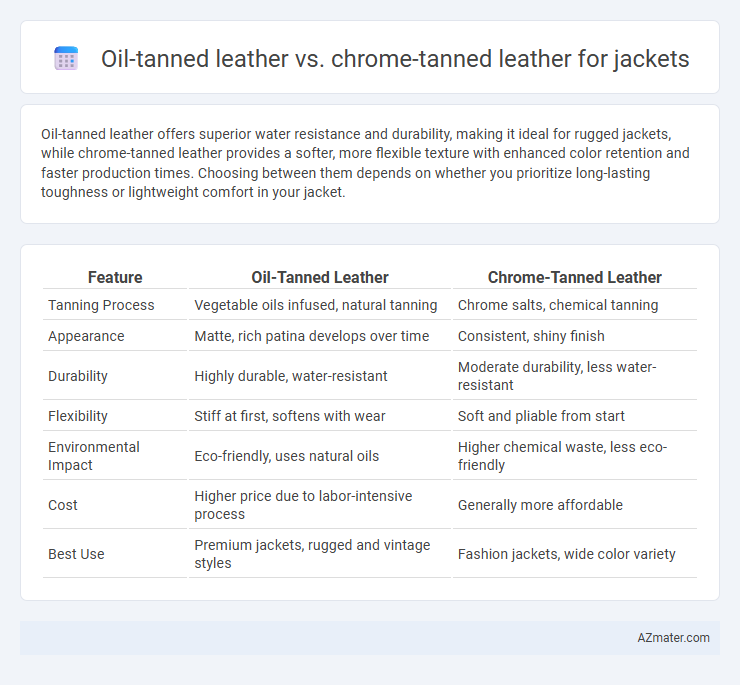Oil-tanned leather offers superior water resistance and durability, making it ideal for rugged jackets, while chrome-tanned leather provides a softer, more flexible texture with enhanced color retention and faster production times. Choosing between them depends on whether you prioritize long-lasting toughness or lightweight comfort in your jacket.
Table of Comparison
| Feature | Oil-Tanned Leather | Chrome-Tanned Leather |
|---|---|---|
| Tanning Process | Vegetable oils infused, natural tanning | Chrome salts, chemical tanning |
| Appearance | Matte, rich patina develops over time | Consistent, shiny finish |
| Durability | Highly durable, water-resistant | Moderate durability, less water-resistant |
| Flexibility | Stiff at first, softens with wear | Soft and pliable from start |
| Environmental Impact | Eco-friendly, uses natural oils | Higher chemical waste, less eco-friendly |
| Cost | Higher price due to labor-intensive process | Generally more affordable |
| Best Use | Premium jackets, rugged and vintage styles | Fashion jackets, wide color variety |
Understanding Oil-Tanned Leather
Oil-tanned leather undergoes a specialized tanning process using natural oils that penetrate the hide, resulting in a durable, water-resistant, and supple material ideal for jackets exposed to harsh weather conditions. This leather type develops a rich patina over time, enhancing its aesthetic appeal and longevity, making each jacket uniquely aged. Unlike chrome-tanned leather, which is treated with chromium salts for a softer and more flexible finish, oil-tanned leather offers superior toughness and better protection against moisture.
What is Chrome-Tanned Leather?
Chrome-tanned leather is processed using chromium salts, primarily chromium sulfate, which accelerates tanning and produces a supple, water-resistant material ideal for jackets. This method enhances durability and color retention while maintaining flexibility and softness, making it suitable for everyday wear. Compared to oil-tanned leather, chrome-tanned leather offers faster production times and consistent texture, catering to diverse fashion and functional demands.
Key Differences in Tanning Processes
Oil-tanned leather undergoes a natural tanning process using oils and waxes that penetrate the hide, resulting in a durable, water-resistant material with a soft, supple texture. Chrome-tanned leather is treated with chromium salts, which speeds up the tanning process and produces a more uniform, stable, and color-consistent leather ideal for mass production. The key difference lies in oil tanning's emphasis on flexibility and water resistance through natural fats, while chrome tanning focuses on efficiency and uniformity through chemical agents.
Durability and Longevity Comparison
Oil-tanned leather exhibits superior durability and water resistance due to its natural oils, making it highly resistant to wear and aging over time. Chrome-tanned leather offers greater flexibility and a softer feel but tends to be less durable, with a higher susceptibility to cracking and fading under prolonged exposure to elements. For long-lasting jacket performance, oil-tanned leather typically outperforms chrome-tanned leather in toughness and lifespan.
Appearance and Texture: A Visual Guide
Oil-tanned leather jackets exhibit a rich, glossy finish with deep, natural hues that darken and develop a unique patina over time, highlighting the leather's rugged character. Chrome-tanned leather offers a smoother, more uniform surface with consistent color retention and a lighter, supple texture that feels soft to the touch. Visual differences include oil-tanned leather's slightly oily sheen and pronounced grain, contrasting with chrome-tanned leather's polished look and fine, even texture.
Breathability and Comfort Factors
Oil-tanned leather offers superior breathability due to its natural oils that keep the material supple and moisture-resistant, enhancing comfort in varying temperatures. Chrome-tanned leather, while more water-resistant and durable, tends to be less breathable because of the heavy chemical treatment, which can cause heat retention and reduced ventilation. For jackets, oil-tanned leather provides a more comfortable, breathable option ideal for extended wear in diverse climates.
Maintenance and Care Requirements
Oil-tanned leather jackets require minimal maintenance due to their naturally water-resistant and durable surface, which only needs occasional cleaning with a damp cloth and conditioning using specialized oils to maintain suppleness and prevent cracking. Chrome-tanned leather jackets demand more frequent care, including regular cleaning with leather-specific products and conditioning to avoid drying and peeling, as chrome tanning makes the leather less water-resistant and more prone to surface damage over time. Proper storage in a cool, dry place away from direct sunlight is essential for both types to preserve their color, texture, and longevity.
Environmental Impact of Each Tanning Method
Oil-tanned leather uses natural oils and waxes that reduce chemical runoff, making it more environmentally friendly compared to chrome-tanned leather, which relies on chromium salts that can contaminate water sources. Chrome tanning is faster and produces more durable leather but poses significant disposal challenges due to toxic waste. Choosing oil-tanned leather supports sustainable practices by minimizing hazardous residues and promoting biodegradability in jacket production.
Best Applications: Which Leather for Your Jacket?
Oil-tanned leather offers superior water resistance and durability, making it ideal for rugged outdoor jackets and motorcycles gear that require long-lasting protection against harsh elements. Chrome-tanned leather provides a softer, more flexible texture with vibrant colors, best suited for fashion-forward jackets and casual wear where comfort and appearance take precedence. Choosing between oil-tanned and chrome-tanned leather depends on whether you prioritize durability and weather resistance or softness and aesthetic appeal in your jacket.
Pros and Cons: Oil-Tanned vs Chrome-Tanned Leather
Oil-tanned leather offers superior water resistance, durability, and a rich, natural patina that improves with age, making it ideal for rugged, long-lasting jackets; however, it tends to be heavier, less breathable, and requires more maintenance compared to chrome-tanned leather. Chrome-tanned leather provides greater softness, flexibility, and color variety, suitable for lightweight, stylish jackets but may lack the same level of durability and develops a less distinct patina over time. Choosing oil-tanned leather favors robust performance and aging characteristics, while chrome-tanned leather prioritizes comfort and aesthetic versatility.

Infographic: Oil-tanned leather vs Chrome-tanned leather for Jacket
 azmater.com
azmater.com